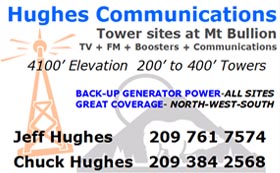 EMERGENCY ALERT SYSTEM Enforcement Advisory 11-06-2013 No. 2013-7
EMERGENCY ALERT SYSTEM Enforcement Advisory 11-06-2013 No. 2013-7
False, Fraudulent or Unauthorized Use of the Emergency Alert System Attention Signal and Codes is Strictly Prohibited
The FCC’s Enforcement Bureau (Bureau) issues this Enforcement Advisory to promote widespread understanding of the laws governing appropriate use of the Emergency Alert System codes and Attention Signal. Any transmission, including broadcast, of the EAS Attention Signal or codes, or a simulation of them, under any circumstances other than a genuine alert or an authorized test of the EAS system violates federal law and undermines the important public safety protections the EAS provides. There is growing concern about the misuse of the EAS tones and Attention Signal to capture audience attention during advertisements and at other times when there is no emergency or test. The FCC may issue sanctions for such violations, including monetary forfeitures.
The EAS is a national public warning system that requires broadcasters, cable television operators, wireless cable operators, wireline video service providers, satellite digital audio radio service providers, and direct broadcast satellite providers to make it possible for the President of the United States to address the American public during a national emergency. Federal, state, and local authorities may also use the EAS to deliver important emergency information, such as AMBER alerts and weather information targeted to specific areas.
In response to numerous consumer complaints, the Bureau recently began several investigations into entities that broadcast, transmitted, or caused to be transmitted content that allegedly used the EAS codes or Attention Signal (or simulations thereof) to capture the audience’s attention in connection with unauthorized uses, including advertisements and promotions. In response to these investigations, the Bureau is releasing two enforcement items concurrently with this Enforcement Advisory.
First, the Bureau is issuing a Notice of Apparent Liability for Forfeiture in the amount of $25,000 to Turner Broadcasting System, Inc. (Turner), for violations of Section 325(a) of the Communications Act of 1934, as amended, and Section 11.45 of the Commission’s rules. Following a complaint from the public concerning Turner’s misuse of EAS codes or Attention Signal, the Bureau investigated and found that Turner produced and transmitted, or caused the transmission of, a promotion for an evening talk show that included a simulation of the EAS Attention Signal.
Second, the Bureau is entering into a $39,000 Consent Decree with MMK License LLC, licensee of a television broadcast station, to settle apparent violations of the ban on unauthorized use of the EAS Attention Signal. The licensee acknowledges broadcasting a commercial that included an auditory signal that simulated the EAS Attention Signal. During the course of our investigation, the licensee cooperated with the Bureau’s inquiries and requests, and voluntarily proposed, and committed to implement, a comprehensive compliance plan and educational program to help deter future violations of the Commission’s EAS rules. The licensee also has agreed to adopt and implement a robust compliance plan that includes employee training and self-reporting of future noncompliance.
How does the EAS work?
EAS uses a four-part message to signal an emergency. The EAS components gain the listener’s or viewer’s attention and convey specially coded information to activate equipment needed in a real emergency. In particular, the EAS codes include sound and encoded information concerning the particular kind of emergency. There is a separate Attention Signal that follows the codes and comprises two tones that are transmitted simultaneously.
What is the FCC’s role in overseeing the EAS?
The FCC, in conjunction with the Federal Emergency Management Agency (FEMA) and the National Oceanic and Atmospheric Administration’s National Weather Service, implements the EAS at the federal level. The FCC’s role includes prescribing rules that establish technical standards for the EAS, procedures for EAS participants to follow in the event the EAS is activated, and EAS testing protocols. Additionally, the FCC ensures that the EAS state and local plans developed by industry conform to the FCC’s EAS regulations. Finally, the FCC enforces rules to ensure that the EAS Attention Signal and tones are not used for unauthorized purposes.
What rules govern the use of the EAS Codes and Attention Signal?
Section 11.45 of the Commission’s rules states that “[n]o person may transmit or cause to transmit the EAS codes or Attention Signal, or a recording or simulation thereof, in any circumstance other than in an actual National, State or Local Area emergency or authorized test of the EAS.” Thus, if advertisements, promotional announcements, or other programming includes the EAS codes or Attention Signal (or simulations thereof) not in connection with an actual emergency or authorized EAS test, they are illegal. A “simulation” of the EAS codes or Attention Signal includes not only recordings of actual EAS codes or Attention Signals, but also sounds that mimic or are substantially similar to them, such that an average listener could reasonably mistake the sounds for an actual EAS code or Attention Signal. By contrast, general alarms or other loud noises, including bells, claxons, and police, fire or civil defense sirens, are not considered “simulations” of the EAS codes or Attention Signal and therefore are not prohibited under section 11.45 of the Commission’s rules.
The rule applies to any “person” who “transmits” or “causes to transmit” a prohibited signal. The prohibition thus applies to programmers that distribute programming containing a prohibited sound regardless of whether or not they deliver the unlawful signal directly to consumers; it also applies to a person who transmits an unlawful signal even if that person did not create or produce the prohibited programming in the first instance. Therefore, the prohibition also applies to a broadcaster, cable operator, or satellite carrier that transmits programming containing a prohibited sound even if the programmer that embedded the sound is not under common ownership or control with the respective broadcaster, operator, or carrier.
Moreover, false or fraudulent use of the EAS codes or Attention Signal (or simulations thereof) may violate Section 325(a) of the Act, which prohibits transmission of false distress signals. For example, in Emmis Broadcasting Co. of St. Louis, the Commission found a radio station in Missouri apparently liable for violating Section 325(a) after the station broadcast a “bleep” that listeners mistook for an authentic emergency signal; the Commission held that using the tone to “cry wolf” undermined the integrity of the Emergency Broadcast System (EBS) and endangered the effectiveness of the EBS warning tone as a method of alerting the public to real danger. The Commission pointed to the broadcast’s effect on the EBS as a factor that exacerbated the violation, even though the station did not use the actual EBS attention signal. At that time, in 1991, the Commission lacked a rule that explicitly prohibited unauthorized or false or fraudulent use of emergency broadcast signals, and relied on Section 325(a). The Commission subsequently proposed and adopted the prohibition in Section 11.45.
For broadcast licensees, false or fraudulent EAS signals also may violate the Commission’s prohibition against the broadcast of hoaxes. Section 73.1217 of the rules prohibits broadcast licensees or permittees from broadcasting false information concerning a crime or a catastrophe if: (1) the licensee knows this information is false; (2) it is foreseeable that broadcast of the information will cause substantial public harm; and (3) broadcast of the information does in fact directly cause substantial public harm. For purposes of this rule, “public harm” must begin immediately and cause direct and actual damage to property or to the health or safety of the general public, or cause diversion of law enforcement or other public health and safety authorities from their duties.
What happens if the Commission’s EAS rules are violated?
Failure to comply with the Communications Act or Commission’s rules may subject a violator to sanctions including, but not limited to, substantial monetary forfeitures. As noted above, the Bureau is issuing a $25,000 Notice of Apparent Liability for Forfeiture to a cable network program provider for violations of Section 325(a) of the Act and Section 11.45 of the Commission’s rules, and has also entered into a Consent Decree with a broadcast licensee, whereby the licensee agreed to make a $39,000 voluntary contribution to the U.S. Treasury, as well as adopt and implement a robust compliance plan. Other investigations remain ongoing, and the Bureau will take further enforcement action if warranted. In the meantime, the Bureau will continue to monitor and enforce compliance with these rules consistent with their importance in promoting and protecting public safety.
What should consumers do if they hear a false or fraudulent EAS Signal?
Consumers who believe they have heard an EAS code or EAS Attention Signal on the radio, television, or other transmission media that is not transmitted in connection with an actual national, state or local emergency or authorized test may contact the FCC at 1-888-CALL-FCC (1-888-225-5322) or file a complaint online at www.fcc.gov/complaints.
Need more information?
For additional information regarding this Enforcement Advisory, please contact Gregory Simon of the Enforcement Bureau at 202-418-1764 or Gregory.Simon@fcc.gov, or Jennifer Lewis of the Enforcement Bureau at 202-418-2051 or Jennifer.Lewis@fcc.gov. Media inquiries should be directed to Mark Wigfield at (202) 418-0253 or Mark.Wigfield@fcc.gov.
For additional information regarding use of the Emergency Alert System, please visit http://fcc.gov/pshs/services/
To request materials in accessible formats for people with disabilities (Braille, large print, electronic files, audio format), send an e-mail to fcc504@fcc.gov or call the Consumer & Governmental Affairs Bureau at 202-418-0530 (voice), (202) 418-0432 (TTY). You may also contact the Enforcement Bureau on its TTY line at (202) 418-1148 for further information about this Enforcement Advisory, or the FCC on its TTY line at 1-888-TELL-FCC (1-888-835-5322) for further information about the Emergency Alert System.
Issued by: Acting Chief, Enforcement Bureau
Here is a PDF version of this article: FCC Enforcement Advisory False EAS Tones


